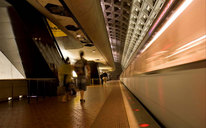Sustainability can save WMATA money, if it’s a priority
Organizations of all types are talking about being “greener,” partly because it’s the right thing to do, but also because it can save money. Amid regular budget shortfalls, WMATA can benefit from every cost savings, and is considering a number of sustainability projects.
Tomorrow, the WMATA Board will hear about the agency’s sustainability initiatives. Sustainability could make a big difference in the budget.
According to a November memo to the Board, more efficient lighting in parking garages could save $1.5 million per year. Doing the same for stations and tunnels could save $5-8 million per year. New lights also generate more light and need less maintenance than the old.
Lighting isn’t the only way that being green could help get rid of the red ink and improve operations at the same time.
Many escalators around the world stop when they’re not being used, and have more efficient motors than Metro’s aging escalators. Solar panels or solar laminates could cover the roofs of Metro railyards, maintenance facilities, and garages.
Other transit agencies have trained operators to accelerate and brake more fuel-efficiently. Many have installed tire pressure gauges that actively and constantly communicate tire air pressure data to the maintenance facilities. That lets them keep buses at optimum tire pressure and fuel efficiency, which saves significant fuel. Fuel is a very large cost item in Metro’s budget, especially with fuel prices rising.
WMATA already has set a standard to make new facilities LEED Silver, like the Shepherd’s Parkway bus garage under construction. Its new buses are cleaner and more efficient than the old, and the 7000 series railcars use LED lights, regenerative braking to get energy back like hybrid cars do, better HVAC systems and a design that reduces the need for some polluting processes to clean them.
Sustainability faces obstacles
It’s often difficult for transit agencies to energetically adopt sustainability programs. Some agency staff think of transit as intrinsically pro-sustainable, compared to other modes of travel, so they might not feel that sustainability is the higest priority. There can be resistance from the rank and file to newfangled, ivory tower ideas that don’t recognize the rough reality of engineering and operations.
Transit agencies also, perhaps understandably, end up prioritizing the day-to-day crisis management over strategic programs. At the moment, WMATA’s the overwhelming emphasis is on system safety and renewal capital projects. That means that “soft,” “green” projects can find it hard to compete for the capital funds available, even when there’s a powerful economic business case behind them.
Another obstacle is the relationship between labor and management. Many sustainability programs might involve changes to people’s job responsibilities, which means that management has to negotiate for a change rather than simply establishing and implementing the program.
For example, if WMATA monitored the fuel efficiency performance of each bus driver to help them save fuel, would the union oppose this as another form of management breathing down workers’ necks? Would WMATA be able to reward employees that saved the most fuel and money?
Even for non-union workers, transit agencies lack many of the tools private sector companies have to reward individual initiative. A private sector employee responsible for annual cost savings might get a bonus as a result, in a transit agency that same employee might simply get an employee appreciation mention in a weekly newsletter. Weighed against the possibility that any given sustainability initiative might “rock the boat” for bosses or colleagues, a public pat on the back doesn’t offer enough to outweigh the possible headaches.
Sustainability initiatives that come from one department might create savings in another department. But the department that initiated the program might not benefit from the savings, reducing the incentive. Also, divisions within public or private sector organizations often covet the size of their respective budgets and the control that spending authority gives.
A department which saves money might view this as reducing “their budget” instead of looking at the benefit to the agency’s bottom line. The affected department could well resent the sustainability initiative and the employees elsewhere in the organization who pushed the idea through.
Making sustainability happen takes leadership from the top
Despite all these barriers, it’s more important than ever that WMATA take a strong leadership role in sustainability, backed up by strong management policy and action. In a budget season when the agency is asking for substantial fare and subsidy increases, the public needs to hear that WMATA is taking every possible action to provide transit services more cost-effectively (not to mention more safely and reliably).
WMATA is also entering negotiations with its labor unions for the next round of labor contracts. It’s critical that the issues of efficiency and productivity be on the table in a central, pivotal way. It’s not unreasonable for labor to ask for wage increases; it’s completely unreasonable to ask for such increases without also committing to improving productivity and efficiency in quantifiable ways.
WMATA management could start most sustainability initiatives without any Board action. Richard Sarles and his management team could unilaterally adopt many measures and communicate the values described here. But, perhaps for many of the reasons listed above, Metro’s management has not yet made sustainability the visible issue it could and should be. That means they need support, and pressure, from the region and the board.
To date, only 2 WMATA Board members have expressed much interest in sustainability: Tom Downs and Mary Hynes. They should both be commended for trying to make this issue a priority for the agency, and hopefully they will continue to do so. Their colleagues should join them in pressing for more sustainability, productivity, and efficiency.

